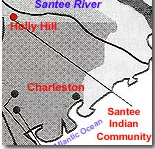
Like most Native Americans in South Carolina, the Santee have a history of trading with early colonists from Europe. In 1701, English explorer John Lawson described his meeting with the "King" of the Santee Indians:
"At these cabins came to visit us the King of the Santee Nation...The Santee King...is most absolute Indian Ruler in these parts, although he is head but of a small people..."
From historical records, it is believed the Santee Indian tribe numbered around one-thousand in the year 1600. Due to disease and other factors, the Santee population dropped to under a hundred in the early 1700s. Today the Santee Indian Tribe is trying to preserve their heritage through historical and archaeological research.
Standards
- This indicator was developed to encourage inquiry into the process which led to the formation of the U.S. government, including the convening of the Continental Congresses, the passage of the Articles of Confederation, and the adoption of the U.S. Constitution.
- This indicator was developed to encourage inquiry into how the three British colonial regions developed in terms of their culture, economies, geography, and labor. The indicator was also developed to encourage inquiry into the unique story of the development of South Carolina.

